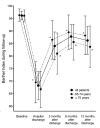Functional status and quality of life 12 months after discharge from a medical ICU in healthy elderly patients: a prospective observational study
- PMID: 21443796
- PMCID: PMC3219378
- DOI: 10.1186/cc10121
Functional status and quality of life 12 months after discharge from a medical ICU in healthy elderly patients: a prospective observational study
Abstract
Introduction: Long-term outcomes of elderly patients after medical ICU care are little known. The aim of the study was to evaluate functional status and quality of life of elderly patients 12 months after discharge from a medical ICU.
Methods: We prospectively studied 112/230 healthy elderly patients (≥ 65 years surviving at least 12 months after ICU discharge) with full functional autonomy without cognitive impairment prior to ICU entry. The main diagnoses at admission using the Acute Physiology and Chronic Health Evaluation III (APACHE III) classification diagnosis and length of ICU stay and ICU scores (APACHE II, Sepsis-related Organ Failure Assessment (SOFA) and OMEGA) at admission and discharge were collected. Comprehensive geriatric assessment included the presence of the main geriatric syndromes and the application of Lawton, Barthel, and Charlson Indexes and Informant Questionnaire on Cognitive Decline to evaluate functionality, comorbidity and cognitive status, respectively. The EuroQol-5D assessed quality of life. Data were collected at baseline, during ICU and ward stay and 3, 6 and 12 months after hospital discharge. Paired or unpaired T-tests compared differences between groups (continuous variables), whereas the chi-square and Fisher exact tests were used for comparing dichotomous variables. For variables significant (P ≤ 0.1) on univariate analysis, a forward multiple regression analysis was performed.
Results: Only 48.9% of patients (mean age: 73.4 ± 5.5 years) were alive 12 months after discharge showing a significant decrease in functional autonomy (Lawton and Barthel Indexes) and quality of life (EuroQol-5D) compared to baseline status (P < 0.001, all). Multivariate analysis showed a higher Barthel Index and EQ-5D vas at hospital discharge to be associated factors of full functional recovery (P < 0.01, both). Thus, in patients with a Barthel Index ≥ 60 or EQ-5D vas ≥ 40 at discharge the hazard ratio for full functional recovery was 4.04 (95% CI: 1.58 to 10.33; P = 0.005) and 6.1 (95% CI: 1.9 to 19.9; P < 0.01), respectively. Geriatric syndromes increased after ICU stay and remained significantly increased during follow-up (P < 0.001).
Conclusions: The survival rate of elderly medical patients 12 months after discharge from the ICU is low (49%), although functional status and quality of life remained similar to baseline in most of the survivors. However, there was a two-fold increase in the prevalence of geriatric syndromes.
Figures




References
-
- Garrouste-Orgeas M, Timsit JF, Montuclard L, Colvez A, Gattolliat O, Philippart F, Rigal G, Misset B, Carlet J. Decision-making process, outcome, and 1-year quality of life of octogenarians referred for intensive care unit admission. Intensive Care Med. 2006;32:1045–1051. doi: 10.1007/s00134-006-0169-7. - DOI - PubMed
Publication types
MeSH terms
LinkOut - more resources
Full Text Sources
Medical

